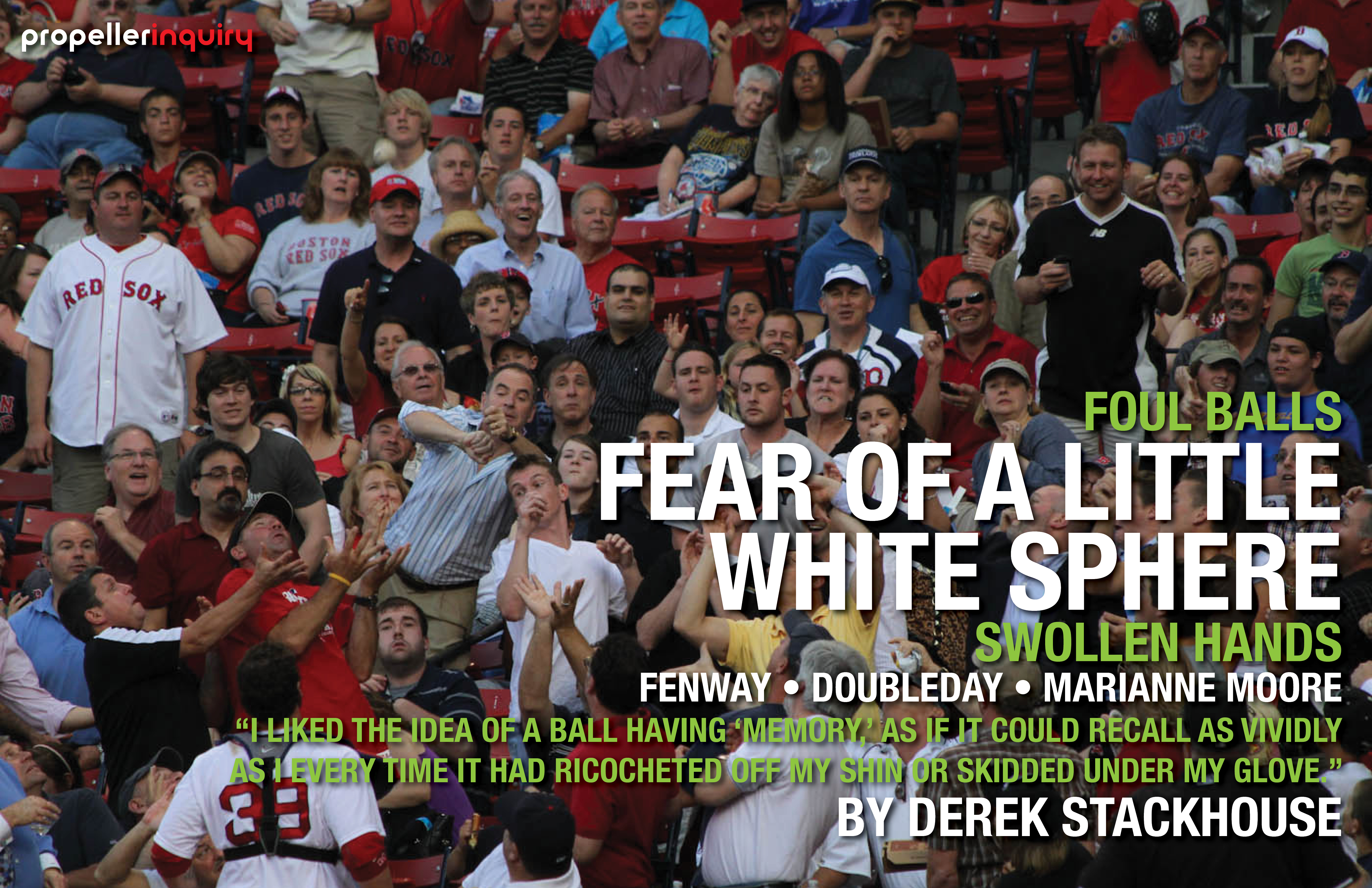
On an especially humid July day in 1995, I grabbed my Red Sox hat and baseball glove from my bedroom dresser and rushed out into the growing heat. As I wandered around the yard, I caught a glimpse of my dad, washing the car that would carry us to the game. Knowing it takes about two hours to drive down I-95 to Boston, I assumed that we would be leaving soon: the man refused to be late. With gray hair curling from underneath his faded blue ball cap, Dad turned off the hose and tossed me the keys to the car, joking that I could drive. Being twelve, I moved towards the driver’s side before tossing them back with a laugh. Winding through the neighborhood towards the highway, Dad said, "How's the glove?" He had given me a tip for breaking it in, making it more able to snag a ground ball or pop fly. The previous several nights, I'd oiled the mitt, placed a baseball inside, and wound it closed tightly with twine. Then, I sandwiched the bundle between my mattress and box spring, hoping that this process would somehow grant me newfound skills on the diamond, knowing that it would take a lot more than some oil and string to accomplish this feat. "Great," I lied.
My father hadn't been home the day before, when a couple of neighborhood kids had come over to practice. Trying to replicate the drills we had learned during Little League practices in the spring, we took turns smacking grounders at each other. This was a precarious situation, seeing as my bumpy yard hardly mirrored the relatively groomed infield at the schoolyard. Every time one of those hard balls skipped up toward my chest or face, I'd turn away and simply throw my glove in the general direction of the culprit. More than once, my well-oiled glove was useless against the onslaught, and the ball would sail past my hand and strike me in the sternum with a resounding thud. I knew that there existed a softer version of the regulation-size baseball, but I was far too embarrassed to suggest these to my friends. Trying to seem tough in front of the others, I'd shake it off and pound back some of my eerily blue sports drink, asking myself why don't they make the balls softer?
As the car merged onto the interstate, I lightly touched one of the bruises suffered during our "practice." My dad, humming some tune, was oblivious to the terror I felt when it came to that damned little ball. After my friends left, I rummaged around the garage and discovered a tube of tennis balls. This was more my style, throwing the soft orbs into the air and catching them with relative ease. My dog looked on anxiously, expecting me to involve her in this at any moment. Was it the fear of getting hurt that kept me from being able to do the same with baseballs? The suggestion by my mom that "softballs might be good practice" did not end well. It turns out that "soft" is a misnomer, for the first tricky groundball that caught me square in the kneecap did not feel very soft. I didn’t fancy myself an especially "wimpy" kid, often partaking in the usual stunts my parents so despised for being dangerous. Only when it came to this object did I cower in fear, then in shame.
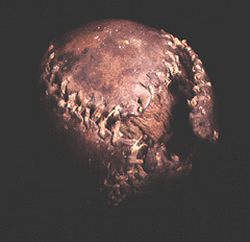 As we sped across the Piscataqua River Bridge into New Hampshire, I asked my father if he knew how a baseball is made. He attempted a rough estimation of the process, which includes beginning with a rubber-cased pill, a sphere in which a smaller cork is nested. Several sorts of yarn are intricately woundaround this, and the type of material used becomes finer as you move away from the center. This gives the ball a kind of resiliency, or memory. I liked the idea of a ball having "memory," as if it could recall as vividly as I every time it had ricocheted off my shin or skidded under my glove. Eventually, the ball is covered in two identical pieces of cowhide that are carefully sewn together. With all of the labor and drying cycles, one ball takes about a week to be readied for use in a game.
As we sped across the Piscataqua River Bridge into New Hampshire, I asked my father if he knew how a baseball is made. He attempted a rough estimation of the process, which includes beginning with a rubber-cased pill, a sphere in which a smaller cork is nested. Several sorts of yarn are intricately woundaround this, and the type of material used becomes finer as you move away from the center. This gives the ball a kind of resiliency, or memory. I liked the idea of a ball having "memory," as if it could recall as vividly as I every time it had ricocheted off my shin or skidded under my glove. Eventually, the ball is covered in two identical pieces of cowhide that are carefully sewn together. With all of the labor and drying cycles, one ball takes about a week to be readied for use in a game.
Baseball Archeology by Gwen Aldridge and Bret Wills documents many of the objects that make up the history of the game, and the first image of the book is indelible: the famous "Doubleday Ball," found a few years ago in upstate New York. Historians date it back to 1839, making it the earliest known ball still in existence. It was the first exhibit brought into the Baseball Hall of Fame in Cooperstown. A close-up shot shows every stitch torn open, exposing a loose mass of grayish yarn inside. I had heard the term "dead ball era" used in reference to the game of the 19th and early 20th century, and this thing sure looked dead to me. This particular baseball is important, for some hold it up as the physical embodiment of the birth of the game, though the myth of Abner Doubleday being the founding father of baseball has long been discredited. Despite the dubious origin of the ball, to many, including sportswriter Steve Wulf, it is an endlessly fascinating object:
It's not just stuffed with cloth but also with the dreams of boys and the sweat of men…the perfect symbol of a game bursting at the seams with 150 years of history and lore. Out of that homely ball, which is the oldest physical evidence of the game anywhere, have sprung the thousands of other artifacts in Cooperstown.
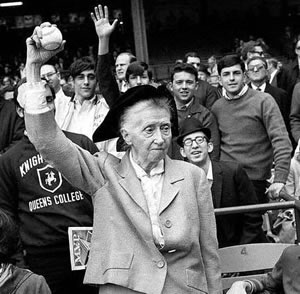 Not only was my dad a fan of the game, he was endlessly interested in "baseball culture." He voraciously read books about the game, and his study was filled with autographed pictures of Ted Williams, Carl Yastrzemski and other legends. My favorite picture he had in this room was of the poet Marianne Moore, a lifelong baseball fan, just before she tosses out a first pitch at Yankee Stadium. Whereas most who are given this honor stand on (or at least near) the pitcher's mound and throw the ball towards a crouching catcher at home plate, the elderly Moore stands next to her seat with her fellow fans. She holds the baseball aloft, but does not seem readying to throw it. Rather, she is displaying it to the crowd, as one may do after snagging a foul ball. When I look at the picture, I always get the feeling that Moore knows the cheers raining down at that moment are for her, but in her gesture there is a deflection of praise: cheer for the baseball, not for me. The thing looked so innocent in the photo, just a little white ball in an old lady’s hand. I knew it was silly to be so afraid of it, yet here I was, wishing that I had taken up tennis.
Not only was my dad a fan of the game, he was endlessly interested in "baseball culture." He voraciously read books about the game, and his study was filled with autographed pictures of Ted Williams, Carl Yastrzemski and other legends. My favorite picture he had in this room was of the poet Marianne Moore, a lifelong baseball fan, just before she tosses out a first pitch at Yankee Stadium. Whereas most who are given this honor stand on (or at least near) the pitcher's mound and throw the ball towards a crouching catcher at home plate, the elderly Moore stands next to her seat with her fellow fans. She holds the baseball aloft, but does not seem readying to throw it. Rather, she is displaying it to the crowd, as one may do after snagging a foul ball. When I look at the picture, I always get the feeling that Moore knows the cheers raining down at that moment are for her, but in her gesture there is a deflection of praise: cheer for the baseball, not for me. The thing looked so innocent in the photo, just a little white ball in an old lady’s hand. I knew it was silly to be so afraid of it, yet here I was, wishing that I had taken up tennis.
Dad loved poetry, songs, movies, books and art in general that was about baseball. Mark Twain and Walt Whitman romanticized the game, and this only solidified its lofty position in his eyes. Robert Frost wrote: "baseball is the fate of us all. For my part I am never more at home in America than at a baseball game…in beautiful weather and my side winning. Beyond this, I know not. And dare not." My dad was quick to remind that Frost’s "side" was our beloved Red Sox. Buster Keaton, one of my father's other heroes, used to play baseball on the sets of his films, between takes. We watched the Ken Burns documentary "Baseball" countless times, especially the tapes covering the 1950s and 60s, the years of Dad’s own childhood. Footage of men like Red Sox shortstop Billy Klaus effortlessly scooping up a ground ball and tossing it to first made it seem as though it were all so easy. I bet Billy didn’t lie in bed at night, dreading the next day’s game. After a viewing of The Sandlot, Dad turned to me and said, "Now that’s a movie!" It involves a group of children attempt to retrieve a baseball lost in a neighbor’s yard, which is guarded by a ferocious dog. This ball is particularly important, as it belongs to one of the boy’s stepfather, and is signed by none other than Babe Ruth. The significance of this is lost on the young man, who sees the baseball as something easily replaced, not some object of veneration.
Soon, we parked outside of Fenway Park and walked into the festivities stretching down the length of Yawkey Way. People slowly shuffled towards the gates of the stadium, sausages sizzling over the din. Cops mounted on horses looked on as men ducked into doorways to buy and sell tickets. Office workers sipping coffee watched as the crowd slowly grew smaller as the first pitch approached. Shuffling through the chaotic corridors, the dimness of the stairwell leading into the park gave way as the field came into view. Everything shimmered: the edges of the scoreboard, the players sunglasses, the bright white ball tossed back and forth between the center and right fielder. We stopped at the top of the stairs to survey the scene, my dad pushing the brim of my hat down, smiling ear to ear. John Updike felt baseball, "with its graceful intermittences of action, its immense and tranquil field sparsely settled with poised men in white…best suited to accommodate a loner. It is an essentially lonely game." My experience has always been the opposite, that of camaraderie. It can be a quiet game, but I never feel alone.
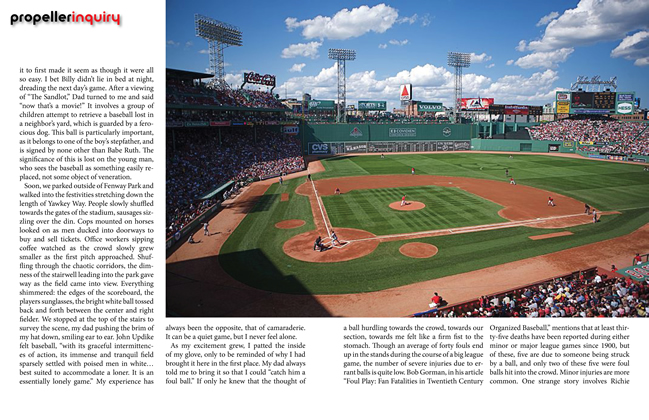
As my excitement grew, I patted the inside of my glove, only to be reminded of why I had brought it here in the first place. My dad always told me to bring it so that I could "catch him a foul ball." If only he knew that the thought of a ball hurdling towards the crowd, towards our section, towards me felt like a firm fist to the stomach. Though an average of forty fouls end up in the stands during the course of a big league game, the number of severe injuries due to errant balls is quite low. Bob Gorman, in his article "Foul Play: Fan Fatalities in Twentieth Century Organized Baseball," mentions that at least thirty-five deaths have been reported during either minor or major league games since 1900, but of these, five are due to someone being struck by a ball, and only two of these five were foul balls hit into the crowd. Minor injuries are more common. One strange story involves Richie Ashburn, who in 1957 struck Alice Roth twice with two separate foul liners. As she was being helped to the exit after the first ball, the second hit her in the back. Thankfully, Roth escaped with relatively minor injuries. A look at the statistics, though, would have been of little comfort for me that day. Just as the probability of dying in a plane crash is extremely slim, many people still harbor an intense fear of flying. As we settled into our seats, I placed my glove under my seat and dug into a bag of peanuts. Dad looked over and said, "You'll be needing that in a minute. This area is foul ball central." You wear it, then, I thought. I lowered my hat to shield my downward eyes, both from the now scorching sun and the slow burn of embarrassment.
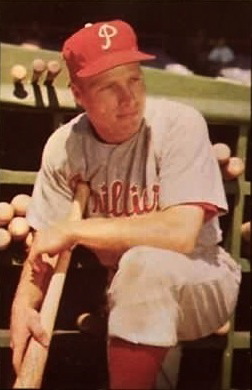 I was fully aware that the equipment I had access to was vastly superior to that used during the "olden days," but the padding on the palm of my glove did little to quell my fear. Robert Klein’s essay "Play Ball!" considers the dangers of the sport early on:
I was fully aware that the equipment I had access to was vastly superior to that used during the "olden days," but the padding on the palm of my glove did little to quell my fear. Robert Klein’s essay "Play Ball!" considers the dangers of the sport early on:
The baseball is absolutely essential to the sport. Indeed, early contests were played without gloves, or with just vague approximations of them. Bats were originally rudely fashioned and crude clubs. But without a baseball, or some object remotely resembling an airworthy spheroid, the game could not exist.
The piece (subtitled "A Selective History of the Round Object That Gives the National Game Its Name") discusses the "poetic primacy" of the ball, how it holds such a distinct place American culture and the collective imagination. In particular, Klein sees the baseball as "a rarity in sports – the in-play, physical connecting object between the fan and the sport." For my father, this may be what the ball represents, but to me, the only "connecting" I could envision was a fierce line drive connecting with my face.
This day was beginning to feel like the inside of an oven, with the sort of weather that makes a native New Englander forget the achingly cold winter of only a few months prior. Oddly enough, the beginning of baseball season in Maine often takes place before this chill has lifted. On more than one occasion, snow had to be shoveled from the field and piled along the foul lines in order to play a game. Wool hats replaced the usual caps, and I recall more than one of my teammates being made to wear his winter coat during batting practice by a concerned mother. This cold meant that the ball would often be even harder than usual, its cowhide nearly crystallized with frost. One crisp April night, I was hit on the forearm with a wayward fastball, and the bump left behind had the perfect imprint of the ball’s stitches. For the rest of the game, I was referred to as "the monster." Only in hindsight does this seem like a funny anecdote, for the pain and embarrassment in the moment sent me behind the dugout so my teammates could not see me sob.
A few innings went by without incident, and as my father began to stand to wave down a nearby vendor, I felt the crowd around us surge upwards. I glanced up and saw a ball sailing high above, just a speck at first but growing rapidly larger. Looking down, I saw my glove sitting pathetically between my feet. I quickly turned towards Dad, his eyes fixed on the plummeting projectile. Every hand seemed to reach up at once. Every hand, that is, but mine. I turned away, ducking slightly and hoping for the best. The crowd’s ahhs grew louder and louder. Suddenly, the man to my right looked past me, towards my dad and exclaimed, "Wow!" Turning the other way, I saw my father's beaming face, the ball resting in his bare left hand. He looked down at me, seeming not to know whether to laugh or cry. My drooping jaw slowly returning to place, he handed me the ball, hoarsely saying, "You’ve got the next one, okay?" Once the excitement wore off, the throbbing pain emerged, though the stoicism of the man was cranked up to ten as he lightly rubbed his red and swollen palm. I inched the glove further under my seat with my foot while pretending to be intrigued by the statistics of the left fielder, not wanting to consider the symbol of my cowardice. I almost forgot it when we readied to leave, and only remembered it when I saw my dad lightly flexing his hand and making a tentative fist.
During the drive home, Dad seemed especially quiet, and I interpreted this as his being disappointed in my reaction to the oft-discussed "foul ball situation." Maybe Updike is right, that baseball brings about loneliness. I asked Dad how his hand felt, and he said he was sure it was not broken, and it was nothing some ice couldn’t take care of. We sat listening to a warbling tape of Creedence Clearwater Revival, talking sparingly about the game: the seventh inning home run, the first baseman's strange moustache, the close play at the plate. We crossed back over the bridge into Maine, and looking down I saw my glove pressed between my seat and the door. The dim yellow light of the highway didn't allow me to see much else in the car, but I did catch a small smile form on my father’s face when I told him that I wanted to play catch when his hand was feeling better. Ω
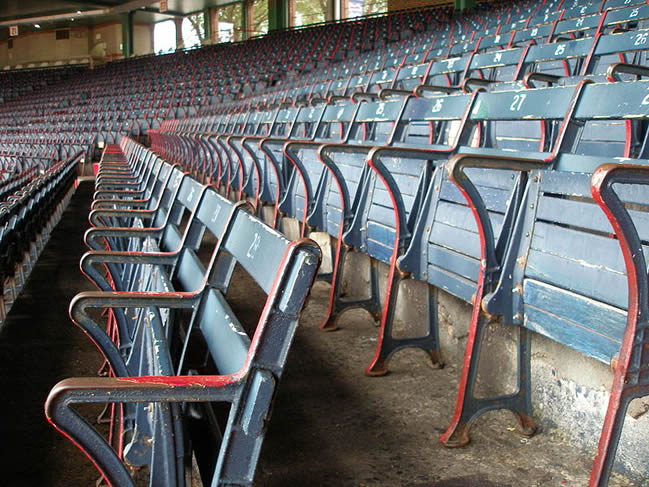
Derek Stackhouse writes about literature and film. He has written, most recently, about use of the term “sublime” in casual conversation.


